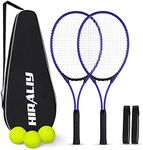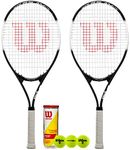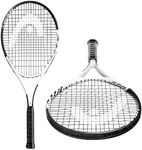Buying Guide for the Best Tennis Rackets
Choosing the right tennis racket can significantly impact your game, whether you're a beginner or an advanced player. The right racket can enhance your performance, provide comfort, and help prevent injuries. When selecting a tennis racket, consider various specifications that cater to your playing style, skill level, and physical attributes. Understanding these key specs will help you make an informed decision and find the best fit for you.Head SizeHead size refers to the surface area of the racket's string bed. It is important because it affects the power and control of your shots. Larger head sizes (100-115 square inches) offer more power and a larger sweet spot, making them ideal for beginners or players who need extra forgiveness. Mid-sized head sizes (85-100 square inches) provide better control and precision, suitable for advanced players who can consistently hit the sweet spot. Choose a head size based on your skill level and playing style.
WeightThe weight of a tennis racket influences its maneuverability and stability. Lighter rackets (8-10 ounces) are easier to handle and swing, making them suitable for beginners, juniors, or players who prefer a faster game. Heavier rackets (10-12 ounces) offer more stability and power, which can benefit advanced players who have developed strength and technique. Consider your physical strength and playing style when selecting the weight of your racket.
BalanceBalance refers to the distribution of weight in the racket, which can be either head-heavy, head-light, or evenly balanced. Head-heavy rackets provide more power and are suitable for baseline players who rely on strong groundstrokes. Head-light rackets offer better maneuverability and control, ideal for net players and those who prefer quick volleys. Evenly balanced rackets provide a mix of power and control, making them versatile for all-court players. Choose a balance that complements your playing style.
Grip SizeGrip size is the circumference of the racket handle and is crucial for comfort and control. A grip that is too small or too large can lead to discomfort and affect your performance. Grip sizes typically range from 4 inches to 4 5/8 inches. To find the right grip size, measure the distance from the middle crease of your palm to the tip of your ring finger. Ensure the grip feels comfortable and secure in your hand to prevent injuries and improve your game.
String PatternString pattern refers to the number of vertical and horizontal strings on the racket. It affects the spin, control, and durability of the strings. Open string patterns (e.g., 16x19) provide more spin and power but may wear out faster. Dense string patterns (e.g., 18x20) offer better control and durability, suitable for players who prioritize precision. Consider your playing style and how often you play when choosing a string pattern.
MaterialTennis rackets are made from various materials, including graphite, aluminum, and composite blends. Graphite rackets are lightweight and provide excellent power and control, making them popular among advanced players. Aluminum rackets are more affordable and durable, suitable for beginners and recreational players. Composite blends offer a balance of performance and durability. Choose a material based on your skill level, playing frequency, and budget.
















